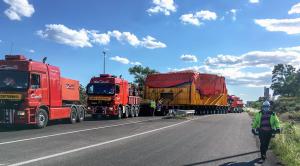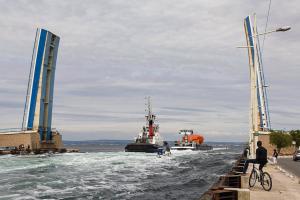Soon to be delivered
The heaviest and widest load to date
15 Jun 2020
Over the past five and a half years, dozens of heavy ITER components have been unloaded at Marseille industrial harbour to be transported along the ITER Itinerary as "highly exceptional loads" to the ITER site. The record so far has belonged to the D-shaped toroidal field coils from Europe and Japan (360 tonnes each) that were delivered to ITER in April. But next week, as poloidal field #6 (PF6) leaves the shores of the inland sea Étang-de-Berre and begins its land journey to ITER, the record will be shattered.
Adding to the weight of the coil proper (400 tonnes), the transport frame and trailer bring the total load close to 800 tonnes. (Photo: DAHER)
Procured by Europe, manufactured by ASIPP in Hefei, China, PF6 is one of the six ring magnets that circle the vacuum vessel of the ITER Tokamak. Sitting at the bottom of the machine, it is the second smallest (10.5 metres in diameter) and yet the heaviest (400 tonnes) of the six.
Adding to the weight of the coil proper, the transport frame and trailer bring the total load close to 800 tonnes.
However, the challenge of transporting this massive component over a distance of 100 kilometres is not so much its weight but its width. The transport frame for the circular coil is just over 11 metres wide, and a few passages along the ITER Itinerary had to be adapted for this component particularly.
A narrow passage between two cliffs was enlarged in the summer of 2018, and the precise topography of a long tree-lined alley was captured by 360-degree 3D scanning in order to identify every single branch that could potentially stand in the way of the convoy, decide where to prune, and plot the best course for the trailer to slalom between obstacles.
PF6 is seen here as it passes the Martigues drawbridge to enter the inland sea Étang-de-Berre. (Photo: Port de Marseille Fos)
PF6, which was unloaded at Marseille harbour on 11 June, is scheduled to reach ITER before the end of this month.
Since January 2015, when a 90-tonne, US-procured electrical transformer reached ITER, 86 "highly exceptional loads" have travelled the ITER Itinerary. Approximately 120 more are expected in the five years to come, including another 16 toroidal field coils and all nine 440-tonne vacuum vessel segments.
Next in line for arrival are toroidal field coil #13 from Japan, and vacuum vessel sector #6 from Korea.



